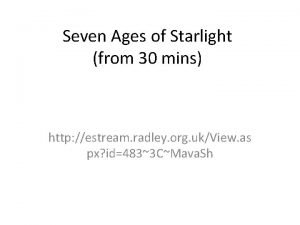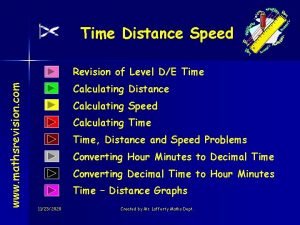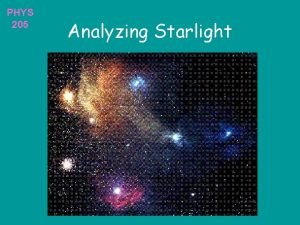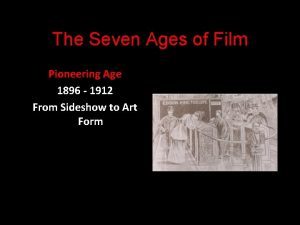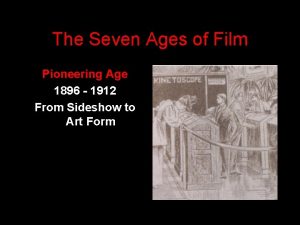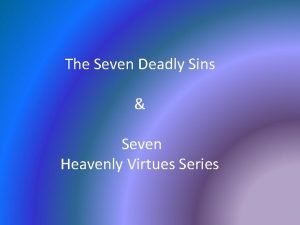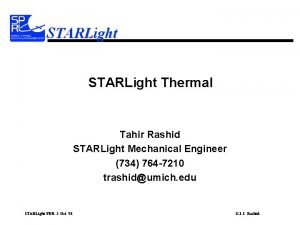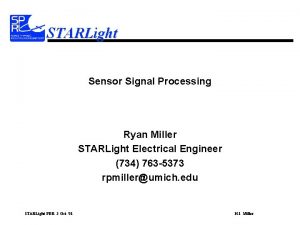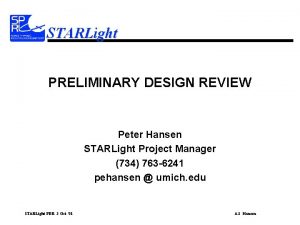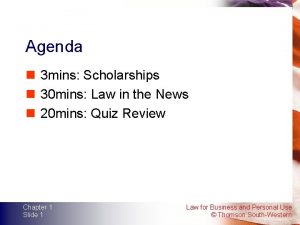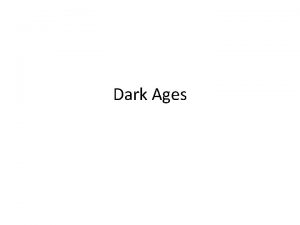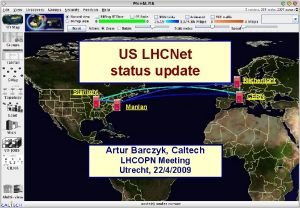Seven Ages of Starlight from 30 mins http




















- Slides: 20

Seven Ages of Starlight (from 30 mins) http: //estream. radley. org. uk/View. as px? id=483~3 C~Mava. Sh

Supernovae and black holes What are these two phenomena and are they linked?

Supernovae A supernovae occurs when a star eventually gets to the end of its life. Collapse occurs and a massive explosion is created. During this collapse electron capture creates a mass of neutrons; a neutron star is created. It has a density the same as that of a nucleon , about 1017 kg m-3

Supernovae

What happens when a star collapses? • The Pauli exclusion principle states that "Electrons cannot be in the same quantum states". This essentially means that they cannot be in the same place in space (with the same energy and quantum numbers) • As star runs out of fuel it collapses. It can only collapse as far as the electrons will allow. When this happens a White Dwarf is created. No fusion is present and this would slowly cool by radiation to make a Black Dwarf • The Chandrasekhar limit is calculated at about 1. 4 solar masses. Beyond this mass it has been calculated that the electron pressure will not stop further collapse

More massive stars (5+ Solar Masses) • The Chandrasekhar limit is calculated at about 1. 4 solar masses. Beyond this mass it has been calculated that the electron pressure will not stop further collapse. • Further collapse would create Neutrons from the Protons and Electrons (hence removing Pauli's principle) and collapse would make a core 1/10000 th the radius! • Upon collapse the star will suddenly stop collapsing when the Neutron stage has no further collapse available. This will create a supernovae and a huge explosion

Typa 1 a Supernovae In a binary system matter can be drawn onto a white dwarf. Once the mass of the White Dwarf exceeds 1. 4 solar masses then core collapse occurs creating a Type Ia supernova.

Type 1 a (or Type 1) supernova • Do NOT contain Hydrogen lines. This is because they form when a White Dwarf (which has no Hydrogen envelope) accretes matter from a binary neighbour. • Once the mass of the White Dwarf exceeds 1. 4 solar masses (Chandrasekhar Limit) it explodes. These are always similar in brightness and have similar light curves (over time) so can be used for distance calculations.

Dark Energy

Dark Energy The three men led two competing teams of astronomers who were trying to use the exploding stars known as Type 1 a supernovae as cosmic lighthouses to limn the expansion of the universe. The goal of both groups was to measure how fast the cosmos, which has been expanding since its fiery birth in the Big Bang 13. 7 billion years ago, was slowing down, and thus to find out if its ultimate fate was to fall back together in what is called a Big Crunch or to drift apart into the darkness. Instead, the two groups found in 1998 that the expansion of the universe was actually speeding up, a conclusion that nobody would have believed if not for the fact that both sets of scientists wound up with the same answer. It was as if, when you tossed your car keys in the air, instead of coming down, they flew faster and faster to the ceiling.

Type II Supernovae Type 2 (Type II) supernova A Type II Supernova contains Hydrogen Lines in its spectrum, this means that the envelope of the star which contains Hydrogen was intact when the star exploded. The absolute magnitude of these varies with stellar mass.

Supernovae energy and Gamma ray bursts • Gamma rays are detected coming from all regions of the cosmos – one possible source for these extremely energetic photons is supernovae explosions • The power output of a supernovae is so large that a type II supernovae can outshine a galaxy that it occurs in. This means that they can be more luminous than 100 billion stars • Type Ia supernovae always have similar intrinsic brightness’s, about 5 billion times the luminosity of our sun

Type 1 a light curve Radioactive decay of 56 Co. has a half life of 77 days The light curve of declines in a type 1 a brightness ( ~ 0. 087 supernova mag /day) for 3 – 4 increases rapidly weeks. (Mainly due to Nickel-56 By about a month decaying) and after maximum then follows a light, the decline half life curve rate has changed (due to the again (to a steady ~ decay of cobalt 0. 015 mag/day) 56 into Iron-56) with the light curve

Stability curve and Iron • Atomic Binding energies show that there is a peak at Iron (Fe 56) • This means that a star can never go beyond Iron creation by means of Nuclear Fusion

Nucleosynthesis beyond Iron and Neutron Capture • Once you get to Iron elements in the periodic table then the coulomb barrier (the repulsion between positive charges) gets to a stage where further nucleosynthesis cannot occur by Proton capture or Alpha capture. • Further nucleosynthesis is possible however from Neutron capture because neutrons are neutral so there is no Coulomb Barrier to overcome.

The rapid process • During a supernova, neutron flux densities are extreme and they overtake the expanding (mainly Hydrogen) envelope of the exploding star. • This means that successive Neutron capture can occur within timescales of much less than a second. • Very large atoms can be created through Beta decay after this process and therefore the stable elements that are eventually formed can include all of the stable elements in the periodic table (up to Uranium) • These elements are then also free of the remaining star remnant and go out into the galaxy to seed new stars and new planets.

Escape velocity and light • You can calculate the escape velocity of a sphere using: • As the mass of a stellar remnant (a neutron star) increases then the escape velocity increases until eventually is exceed the speed of light:

Schwarzschild radius • As you move away from a source of gravity then the gravity field decreases in strength. • Rearranging this formula you can calculate how far from a spherical body the escape velocity will be greater than the speed of light.

Calculations • What is the Schwarzschild radius of a black hole with mass of 2. 50 solar masses? • A super-massive black hole resides at the centre of the Milky Way galaxy. If it has a Schwarzschild radius of 30. 1 AU, what is its mass (in solar masses)?

 How to calculate the schwarzschild radius
How to calculate the schwarzschild radius Speed tdst
Speed tdst 60 minute hour
60 minute hour 65 mins
65 mins Dark ages def
Dark ages def Renaissance art vs medieval art
Renaissance art vs medieval art Rf starlight
Rf starlight Analyzing starlight
Analyzing starlight Starlight italia
Starlight italia Starlight assistant
Starlight assistant Gone with the wind cartoon
Gone with the wind cartoon The pioneering age of film was started in the year
The pioneering age of film was started in the year What are the 7 church ages
What are the 7 church ages Seven deadly sins seven heavenly virtues
Seven deadly sins seven heavenly virtues Http //mbs.meb.gov.tr/ http //www.alantercihleri.com
Http //mbs.meb.gov.tr/ http //www.alantercihleri.com Http //siat.ung.ac.id atau http //pmb.ung.ac.id
Http //siat.ung.ac.id atau http //pmb.ung.ac.id The middle ages 1066-1485 unit test
The middle ages 1066-1485 unit test Sacred music in the middle ages
Sacred music in the middle ages An invention in the electromechanical age
An invention in the electromechanical age Tang and song dynasty venn diagram
Tang and song dynasty venn diagram Photo collage about socialization and enculturation,
Photo collage about socialization and enculturation,
